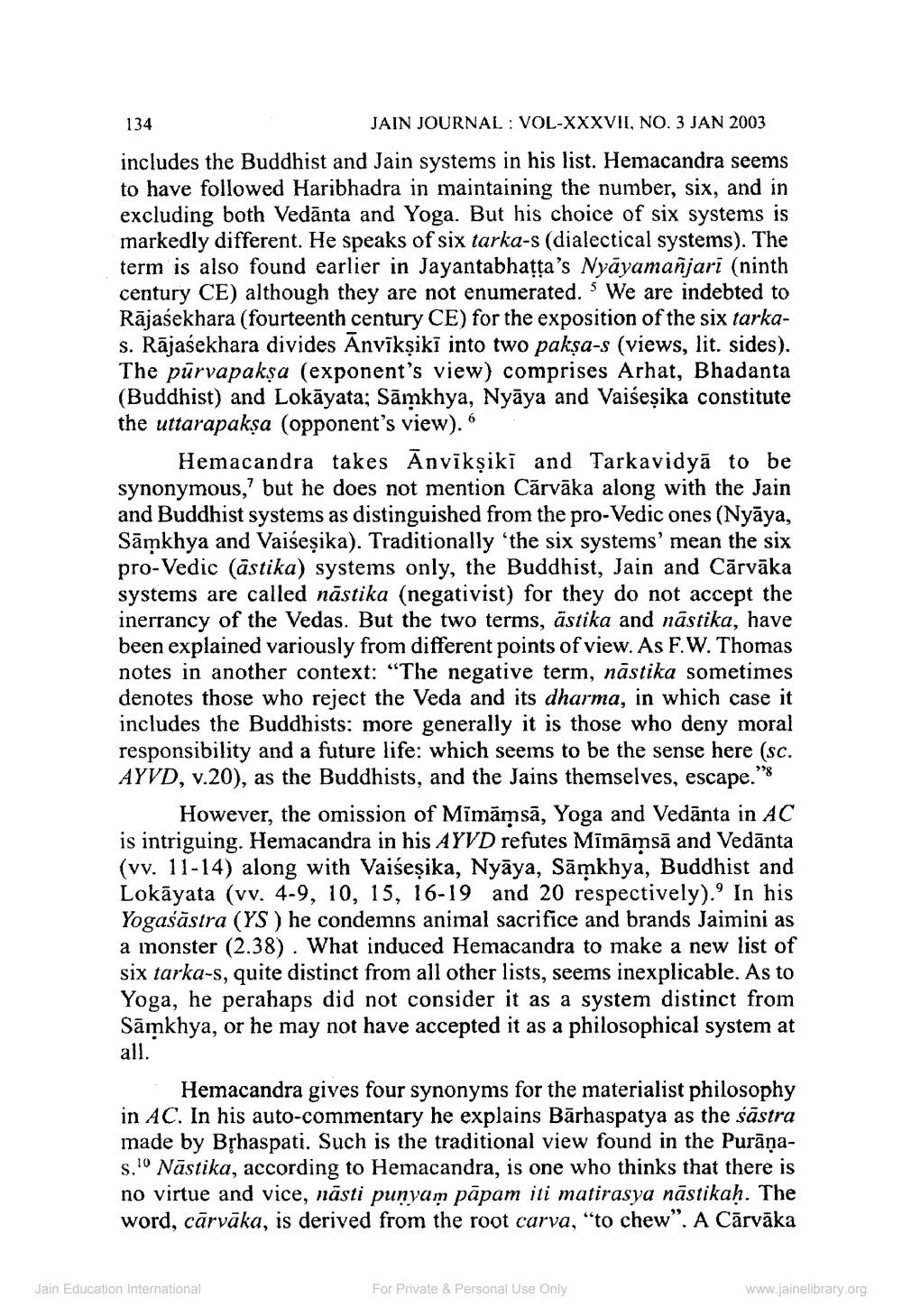Book Title: Jain Journal 2003 01 Author(s): Jain Bhawan Publication Publisher: Jain Bhawan Publication View full book textPage 7
________________ 134 JAIN JOURNAL : VOL-XXXVII, NO. 3 JAN 2003 includes the Buddhist and Jain systems in his list. Hemacandra seems to have followed Haribhadra in maintaining the number, six, and in excluding both Vedānta and Yoga. But his choice of six systems is markedly different. He speaks of six tarka-s (dialectical systems). The term is also found earlier in Jayantabhatta's Nyāyamañjarī (ninth century CE) although they are not enumerated. S We are indebted to Rājasekhara (fourteenth century CE) for the exposition of the six tarkas. Rājasekhara divides Anvīksikī into two pakşa-s (views, lit. sides). The pūrvapaksa (exponent's view) comprises Arhat, Bhadanta (Buddhist) and Lokāyata; Samkhya, Nyāya and Vaišeșika constitute the uttarapaksa (opponent's view).“ Hemacandra takes Ānviksiki and Tarkavidyā to be synonymous, but he does not mention Cārvāka along with the Jain and Buddhist systems as distinguished from the pro-Vedic ones (Nyāya, Sāmkhya and Vaiseșika). Traditionally 'the six systems' mean the six pro-Vedic (ästika) systems only, the Buddhist, Jain and Cārvāka systems are called nāstika (negativist) for they do not accept the inerrancy of the Vedas. But the two terms, āstika and nāstika, have been explained variously from different points of view. As F.W. Thomas notes in another context: “The negative term, nāstika sometimes denotes those who reject the Veda and its dharma, in which case it includes the Buddhists: more generally it is those who deny moral responsibility and a future life: which seems to be the sense here (sc. AYVD, v.20), as the Buddhists, and the Jains themselves, escape.” However, the omission of Mīmāmsā, Yoga and Vedānta in AC is intriguing. Hemacandra in his AYVD refutes Mīmāmsā and Vedānta (vv. 11-14) along with Vaisesika, Nyāya, Sāmkhya, Buddhist and Lokāyata (vv. 4-9, 10, 15, 16-19 and 20 respectively).' In his Yogaśāstra (YS ) he condemns animal sacrifice and brands Jaimini as a monster (2.38). What induced Hemacandra to make a new list of tarka-s, quite distinct from all other lists, seems inexplicable. As to Yoga, he perahaps did not consider it as a system distinct from Sāmkhya, or he may not have accepted it as a philosophical system at all. Hemacandra gives four synonyms for the materialist philosophy in AC. In his auto-commentary he explains Bārhaspatya as the sāstra made by Brhaspati. Such is the traditional view found in the Purāņas.'Nāstika, according to Hemacandra, is one who thinks that there is no virtue and vice, nāsti punyam pāpam iti matirasya nāstikah. The word, cārvāka, is derived from the root carva, "to chew". A Cārvāka Jain Education International For Private & Personal Use Only www.jainelibrary.orgPage Navigation
1 ... 5 6 7 8 9 10 11 12 13 14 15 16 17 18 19 20 21 22 23 24 25 26 27 28 29 30 31 32 33 34 35 36 37 38 39 40 41 42 43 44 45 46 47 48 49 50 51 52 53 54 55 56 57 58
